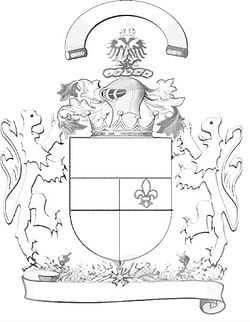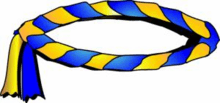Torse

In heraldry, a torse or wreath is a twisted roll of fabric laid about the top of the helm and the base of the crest, from which the mantling hangs.
It was originally a protective pad worn under a knight's coif and helmet, covered by a pair of ribbons, of the principal tinctures of the shield, twisted together and extended far enough down the back to be seen beneath the helmet from the rear.[citation needed]

The torse is sometimes mistakenly said to be the token, such as a handkerchief or sleeve, which the crusader’s lady-love gave him when he left for the wars, and which he twisted round the top of his helmet, masking the join where the crest was fixed to it. This is due greatly to its original use being lost in history as the heraldic crest became more and more stylized rather than representative of actual use.
The torse is blazoned as part of the crest. For example, the crest of the Coat of Arms of Canada is blazoned On a wreath of the colours Argent and Gules, a lion passant guardant Or. Like the mantling, it must be of a metal and a colour; usually the torse and the mantling are the same tinctures. In British heraldry, the torse is always of six twists of material with the metal being the first tincture displayed on the dexter side, then alternating with a colour or stain.[1]
The torse is also often used as a decoration on a heraldic animal, either across the brow (as a form of circlet) or around the neck.[citation needed]